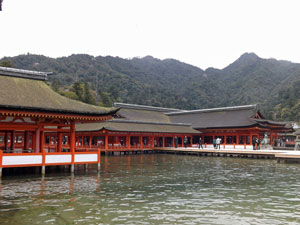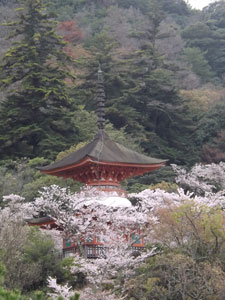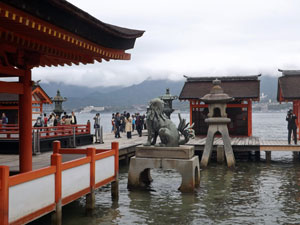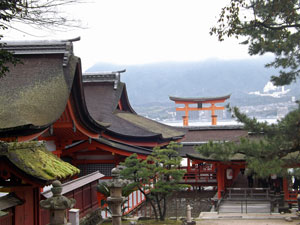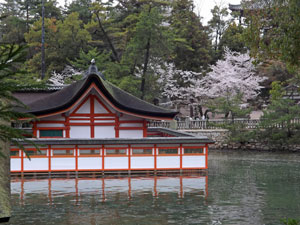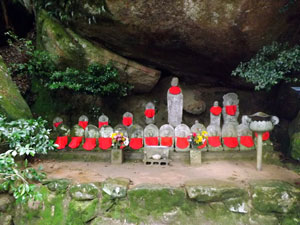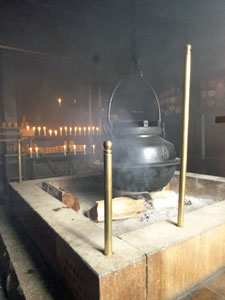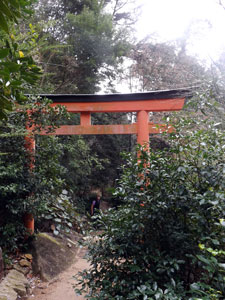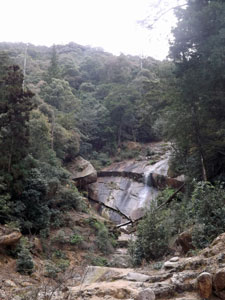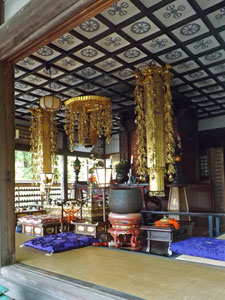| A stroll around Miyajima |
First a few hours in Hiroshima |
Travel in Japan goes like clockwork - in the morning we were in the Kuju Mountains of central Kyushu and, by lunchtime (via car and train), we were 500 km away on a tram in Hiroshima city. The only difference was that in Kuju it was dry and here it was pouring with rain. Our destination was the A-bomb dome, epicentre of the explosion of the first atomic bomb to be dropped, in August 1945, and the Peace Memorial Park, dedicated to the 150,000 victims of that bomb. The one place we could find shelter from the wind and rain was in the Peace Memorial Museum, which provided a sobering account of the destruction and suffering caused by the atomic bomb. After visiting the museum, this vibrant, brand new city all around us, and even the beauty of the cherry blossoms dripping wet in the park, seemed somewhat incongruous. I guess we are seeing the two extremes of humanity - the capacity for great destruction and ugliness the capacity for great creation and beauty. Time for a bit of reflection. |
|
 |
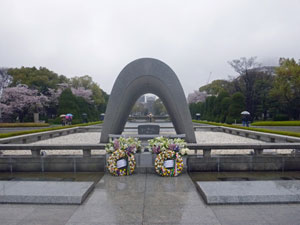 Wet day in Hiroshima Peace Memorial Park |
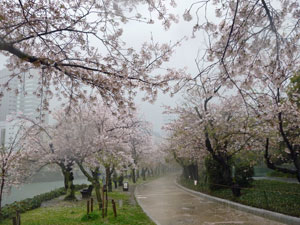 |
Day-walk on Miyajima (10 km - 600m ascent - 600m descent) |
It was great relief to see that the rain had passed, even if the weather remained overcast. We boarded the fast ferry for the island of Miyajima from our hotel near Hiroshima Port and headed off across the Inland Sea. The nearby islands were swathed in low cloud and the mountains of Shikoku appeared hazy on the horizon as we made the 20-minute crossing.
The rugged profile of Miyajima loomed large and soon we docked at the island port. We had caught the first ferry of the day to try and beat the bulk of the tourists - Miyajima is considered one of the top three beauty spots by the Japanese and, as today was a Saturday, crowds could be expected. |
||
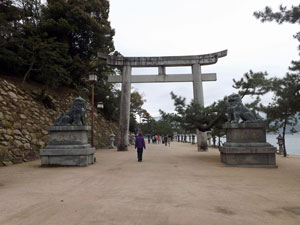 Seaside promenade |
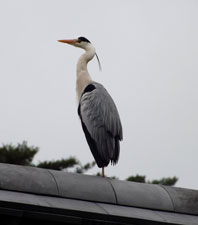 |
 View over the bay at Miyajima |
On disembarking, we followed the seaside promenade, lined with pines and cherry blossoms, and later with stone statues and lanterns that led us to the great attraction of the island - the 16m high red lacquered Torii Gate set in the bay in front of the Itsukushimajinja Shrine. We were fortunate that we had arrived almost at high tide, when the gate seems to float in the water. |
||
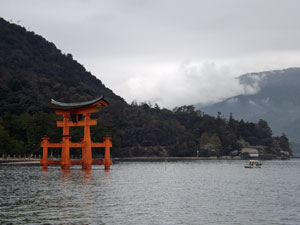 Tide's in at Miyajima |
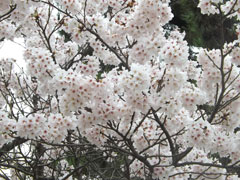 |
 The Ohtorii Gate "floating" in the bay |
The shrine itself, founded in the 6th century and whose current buildings date to the 16th century also seemed to float on their pylons above the shallow bay. The simplicity of the architecture of these red-painted pavilions and walkways was striking - it was a place with the potential for deep serenity. I say "potential" because, once the tourists arrive in their droves at this tourist mecca, that serenity is lost. |
||
|
Leaving the shrine, we wondered past the five-tiered pagoda, framed by cherry blossoms, and headed up through the manicured gardens of Momijidani Park to the cable car heading up to Mt Misen. Our plan had always been to climb this highest point of the island, but with 90% humidity and a strong chance of rain, we took the easy route.
|
|
From the cable car terminus on Shishi-iwa Peak, we still climbed another 100m on a well-formed path up through the lush green forest to the 535m peak and its jumble of giant boulders. Unfortunately, the fabled views over the Inland Sea and its islands were shrouded in the mists. |
|
On the way to the summit of Mt Misen, we passed several sacred sites attributed to the buddhist monk, Kobo Daishi, who lived here in the early 9th century. One, the Reikado Hall, contains the eternal flame which has burnt continuously beneath a giant cauldron for 1200 years. When we passed by, it seemed more like an eternal smoulder (I would certainly have been blowing on the embers).
|
|
Heading back down on foot, we detoured to visit the Miyamajinja Shrine, seemingly more authentic with its small faded-red pavilions and superb setting overlooking the steep green-clad slopes of the mountain. Even better, few tourists go there and its serenity was intact. |
||
The long stepped descent continued, down through the dense green vegetation of the mountain, following the course of a stream, eroding into the soft soil of the steep slopes or pouring over the smooth bed-rock in a series of cascades. The natural scenery of the island is equal to the man-made attractions. |
|
||
 The rich forest below Mt Misen |
 |
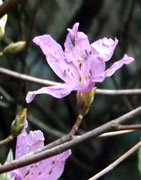 |
|
The track that we descended led us to Daisho-in, the temple founded by Kobo Daishi in 806AD - it was worth a visit for its setting nestled into the mountain and its many buildings, halls and buddhist sculptures. |
|
|
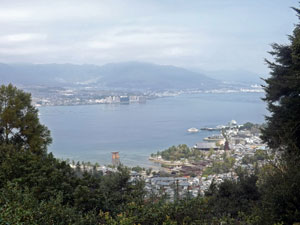 View over Miyajima village |
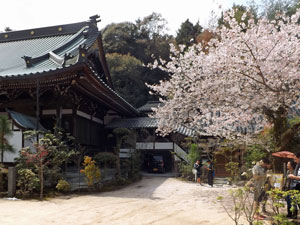 A building in Daisho-in temple |
|
It was interesting though to compare the Daisho temple with the elegant simplicity of the nearby shinto shrine. Buddhist temples are "busy" places - at Daisho-in, there are thousands of buddhas, fat buddhas, thin buddhas, child buddhas, old buddhas, smiling buddhas, angry buddhas, buddhas wearing bibs and buddhas wearing beanies, as well as the usual bells, gongs and incense. I found myself more inclined towards the Shinto view of a place of worship. |
||
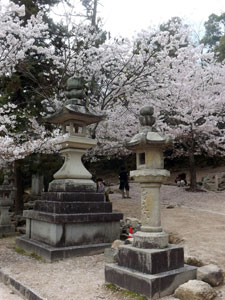 |
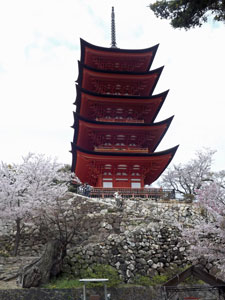 |
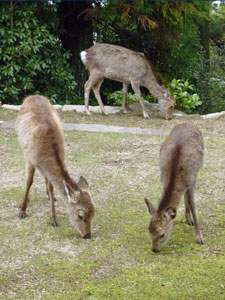 |
 |
Then it was back to modern times, wandering down the streets of Miyajama village, beneath the falling pink blossoms of the cherry trees, along with the island's deer (considered messenger of the gods in shinto, but more like thieves of tourist's food from what we saw) and a throng of tourists. After a long stop at a coffee shop to engage in one of the fair Nello's favourite pastimes - people-watching - we headed back to the ferry terminal for the trip home. |
|||
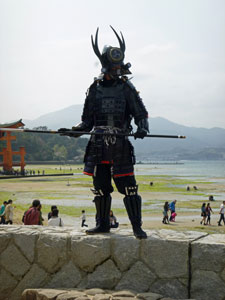 The samurai |
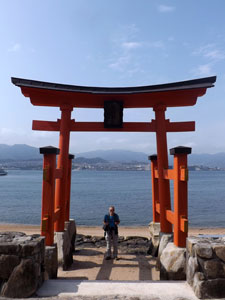 |
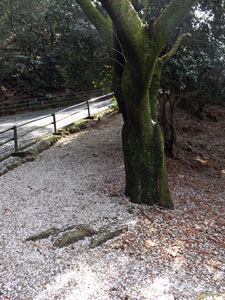 A carpet of petals |
|
 |
|
A bit of culture, a bit of history, a bit of nature - Miyajima had it all. We even returned dry, as the rain held off - a fact we appreciated even more that evening when we were sitting on the 23rd floor lounge of our hotel, sipping a beer and watching the lightning illuminate the sky above the lights of Hiroshima. |
||
|







